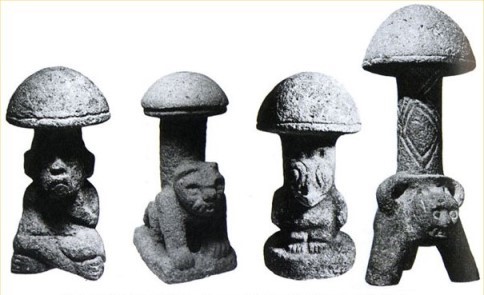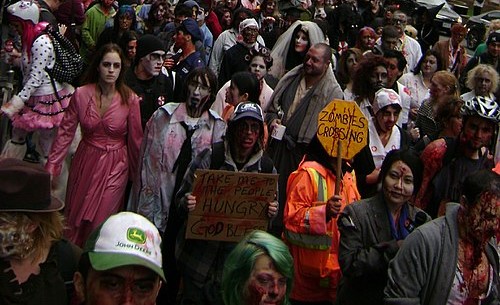Pandemics, Psychedelics and Timothy Leary, Part 1

Various mushroom stones (apprx 1 foot tall, 1000BC to 500AD ^)I spent much of 2020 hoping to travel but the pandemic kept the world in lockdown. Although some intrepid souls were still getting around, most felt stuck in one place. Travelers were forced to self-isolate for two weeks upon returning home – a luxury few could afford. Social distancing kept us apart while government-mandated masks made “everyday people” look like bandits.
The media stoked fears on a daily basis. Each day I heard people ranting and raving about politics and how things are only getting worse.
Enemies were both real and imagined. Angry people began smashing things. Each end of the political spectrum blamed the other for all kinds of horror while ministers of propaganda added fuel to the fire.
An Epidemic of Insanity
All of this has grave consequences as mental illness becomes more prevalent (1). The future is less certain and tales of low self-esteem, depression and victimhood are common (2).
If you always thought insanity was on the rise, recent times have proved especially looney. Anger is contagious and a “cancel culture” now exists where people can lose their jobs for disagreeing with extremists. The term “zombie” has become more popular than ever. Economists say there are too many “zombie” companies in America. Popular culture features TV series like the “Walking Dead”, and pre-pandemic “zombie walks” were seen in many cities:

https://creativecommons.org/licenses/by-sa/3.0/deed.en)
In 2011 the Center for Disease Control (CDC) “warned” the public to prepare for a sort of zombie apocalypse (3).
Today, there are zombies of all kinds. In December, a friend of mine was attacked while working out at a gym. Spinning three machines away, the creature groaned he was “breathing too hard”!
Now it is quite normal to breath hard in a gym – especially while using cardio equipment. But if one is so afraid of an airborne virus, why would you go to a gym in the first place? People pant there.
The intolerant person soon grabbed my buddy and tried to pull him off a moving treadmill. Fortunately no one was hurt and black-masked staff escorted the attacker to the door.
The whole episode seems to make little sense but I think the problem is not simply the zombification, mainstream media or a virus.
It seems the worst monster of all lives inside the head.
Medicine for a Mad World
With enough stress, mind monsters can multiply on a daily basis. Due to Rona and restrictions, consumers are locked down and the economy is in danger. Entrepreneurs are watching their dreams evaporate as small business takes the hit.
The threat to livelihoods is worrisome and many “experts” are predicting a dark “depression” greater than the world has ever seen (see various books and interviews with Jim Rickards, Charlie Munger, Ray Dalio, etc, etc.) after the so-called “everything” bubble bursts.
A systematic review of research literature by BMC Public Health concludes that “periods of economic recession are possibly associated with a higher prevalence of mental health problems” (4). What might seem obvious about recessions is extra daunting when you consider the impact of a super-depression.
If you think the extremists are crazy now, you ain’t seen nothing yet!
People might start looking for “enemies” to blame. Irrationality might rule the day. Consider what happened to Germany in the 1930s or Bolshevik Russia during the time of the First World War. Recall how a combination of economics and mass psychosis led to enormous human costs and genocide by rabid proponents of both far left and right:
“The Fascist and Syndicalist species were characterized by the first appearance of a type of man who “did not care to give reasons or even to be right” but who was simply resolved to impose his opinions. That was the novelty: the right not to be right, not to be reasonable: “the reason of unreason.”
— from chapter 8, “Why the Masses Intervene in Everything and Why They Always Intervene Violently”, in The Revolt of the Masses by Jose Ortega y Gasset.
As someone who values liberty, I have no interest in reinforcing the control-oriented doctrines of an elite vis-à-vis Ortega y Gasset (especially of an elite who are often more revolting than the masses!) but do recognize that Western traditions concerning human rights, the rule of law, free speech, conversation and representation seem to be falling by the wayside while intolerant mobs smash small business windows and zombies attack fellow patrons at the gym. (BTW. The “intolerant mobs” I am talking about here are not peaceful demonstrators who have something legitimate to protest like unlawful activities by authorities).
We have seen it before in places like Bolshevik Russia and Nazi Germany. In discussing Jung’s Wotan archetype, dream researcher Robert Moss discusses the mind monsters present in Europe of the 1930s:
“As the full horror of Nazism unfolded, he (Carl Jung) came to believe not only that Hitler was possessed by a dark force but also that the collective mind of the German people had been possessed… that there are forces at work in history that been identified as gods or demons, and that these may be friendly, hostile, or inimical to humans who have transactions with them”.
(page 223, The Secret History of Dreaming by Robert Moss, New World Library, Novato California, 2009).
A mind-eating monster is possessing the public mind; taking over political institutions, technology and mainstream media. Extremism is again rearing its ugly head and there is nothing new or even rational about this Kraken-like beast.
The evening news sometimes sounds like Lovecraft’s Call of Cthulhu:
The time would be easy to know, for then mankind would have become as the Great Old Ones; free and wild and beyond good and evil, with laws and morals thrown aside and all men shouting and killing and reveling in joy”.
– from H.P. Lovecraft, The Call of Cthulhu
A Kraken-esque monster like Cthulhu is waking. Like the rise of communism and fascism, this creature is emerging from the depths of the collective psyche like the original 1930s monster rising from the dark Scottish loch*.
"Daddy only stares into the distance There's only so much more that he can take ...Many miles away Something crawls to the surface Of a dark Scottish lake". - Lyrics by Sting, Synchronicity II
The monster we see rising to the surface is synchronous with the intolerant and unrelenting extremism of our time.
So what’s a pandemic-ridden civilization to do? How do we keep the monsters at bay?
We might consider ancient wisdom from the indigenous peoples of the Earth. Promising research seems to be vindicating earlier use of psychedelics.
Outside of our modern civilization, indigenous people use psychoactive compounds to keep spirits in check. Anthropologists explain these substances play an important social and psychological role in these cultures.
Mind-altering perceptions and visions from hallucinogens are thought to guide users and healers. For example, shamans use altered states of mind to communicate with otherworldly entities, asking them to intercede on behalf of a community member experiencing a ‘loss of soul’ (or what we might call “mental illness”).
Not a moment too soon, the psychoactive is re-emerging. Research has shown that medical marijuana can be useful in helping one cope with insomnia, anxiety, spasticity, and pain to treating potentially life-threatening conditions such as epilepsy (5).
Such awareness has opened the doors for research into other “illicit” drugs, like psychedelics. In my home country of Canada, psychedelic research dates back to the 1950s:
“Much of that pioneering research took place in Saskatchewan at the Weyburn Mental Hospital under the direction of Humphry Osmond an English psychiatrist, and, Abram Hoffer a Canadian biochemist, who were given great freedom to follow their medical instincts by the government of then-premier Tommy Douglas…. Drs. Osmond and Hoffer began experimenting with LSD, mescaline and peyote in order to find an alternative to the brutal methods of electroshock and lobotomy that were often used for treating mental disorders at the time… All this exploration of the human psyche came to a sudden halt in the late 1960s when politicians, reacting to the growing recreational use of LSD, peyote and psilocybin, reclassified these substances as dangerous drugs with no medical value”(6).
Recently, the Canadian government (Health Canada) re-opened its group mind and are allowing some doctors to use psilocybin (magic mushrooms) to develop therapies.
The same is happening in the USA, once the home of Harvard Psychologist Dr. Timothy Leary who first popularized psychedelics in the 1960s (more on Leary in Part II):
“In 2018 the United States FDA granted “breakthrough therapy” designation for psilocybin-assisted therapy for treatment-resistant major depressive disorder… Some research has shown that these substances have helped people with such mental disorders as OCD, PTSD, alcoholism, depression and cluster headaches” (7).
Decriminalized but Legalization Has Not Yet Been Fully Realized
“Psychedelic mushrooms have been decriminalized in Denver, CO, Oakland, CA, Santa Cruz, CA, Ann Arbor, MI, and Washington, DC, as the movement to decriminalize this potentially valuable compound gains traction.” (8).
“In May 2019, Denver Colorado, became the first city in the United States to decriminalize psilocybin mushrooms after an ordinance was admitted to the ballot, and narrowly won with 50.6% of the vote. The initiative did not actually legalize mushrooms, but does prohibit Denver from spending any resources to prosecute people for their use or possession” (9).
Update (March, 2021): A proposed new law that “would allow the possession, cultivation, use, and ‘sharing’ of most psychedelic drugs in California was introduced in the state Legislature” in February. of 2021. ^^
Although legalization has some way to go, research results have been so encouraging that many new psychedelic research and therapy companies have sprouted up. In 2020, stock prices for these companies soared, making some investors believe psychedelics could be the same sort of boon as pot stocks two years prior (10). Among the proponents are those who adamantly believe in the product as a force for good that needs decriminalization and legalization.
According to researchers, there is hope that psychedelics can help alleviate mental illness in a pandemic, post-pandemic and economically depressed world. If the “acceptable” (meaning non-hullcinatory) properties of psychedelics can be put into a workable medicine, we might be able to effectively treat mental disorders, allowing people a better quality of life.
Before unpacking this notion, we might take a look at the bizarre history of psychedelics and psychiatry – more on this in Part II (Dr. Leary) and Part III (Mind Control).
Psychiatry in Need
About 1 in 5 Americans experience some form of mental illness in their lifetime (11). In Argentina where economic woe has been depression-like, the mental illness experiencer rate is said to be 1 in 4.
Matters are made worse by the chronic shortage of psychiatrists. At present there are not enough professionals for all those suffering and this seems to be the case for every county in the world (13).
This chronic shortage is made worse by the fact that psychiatrists have one of the highest suicide rates of any profession:
“In the US, physicians have the highest suicide rate of any profession (28 to 40 per 100,000), more than double that of the general population (12.3 per 100,000). What’s more, of all the medical specialties, psychiatry is near the top in terms of suicide rates”.
see https://medium.com/invisible-illness/psychiatrists-have-the-highest-suicide-rate-of-any-profession-its-time-to-do-something-about-it-7d63e2f2fe21
Ironically, many psychiatrists can’t even help themselves!
Instead of releasing the Kraken, we might want to release the Shaman!

(To be continued in Part II). – Post by Andrew James Brown
- see https://www.apa.org/news/press/releases/2020/10/stress-mental-health-crisis and https://www.washingtonpost.com/health/2020/05/04/mental-health-coronavirus/ and https://www.forbes.com/sites/geekgirlrising/2020/04/06/half-of-americans-say-covid-19-is-hurting-their-mental-health-new-poll-shows/?sh=34693db351e3
- https://www.kff.org/coronavirus-covid-19/issue-brief/the-implications-of-covid-19-for-mental-health-and-substance-use/
- https://www.foxnews.com/health/cdc-warns-public-to-prepare-for-zombie-apocalypse
- https://bmcpublichealth.biomedcentral.com/articles/10.1186/s12889-016-2720-y
- https://www.health.harvard.edu/blog/medical-marijuana-2018011513085
- https://www.universityaffairs.ca/features/feature-article/the-canadian-revival-of-psychedelic-drug-research/
- see Wikipedia article on “Psychedelic Drug”: https://en.wikipedia.org/wiki/Psychedelic_drug
- https://foodrevolution.org/blog/mushrooms-nutrition-benefits-risks/?utm_source=ontraport&utm_medium=email&utm_campaign=blo-2021&utm_content=mushrooms-frn-members-frn-weekly&utm_term=variant-2-of-2
- see Wikipedia article on the Psilocybin Mushroom https://en.wikipedia.org/wiki/Psilocybin_mushroom
- https://www.japantimes.co.jp/news/2020/12/15/national/psychedelics-marijuana-investment/
- https://www.nami.org/mhstats#:~:text=20.6%25%20of%20U.S.%20adults%20experienced,represents%201%20in%2020%20adults
- https://www.thebubble.com/world-health-day-the-who-reports-depression-is-the-leading-illness-in-the-world#:~:text=The%20Argentine%20Department%20of%20Health,some%20point%20in%20their%20lives
- https://www.modernhealthcare.com/article/20150715/NEWS/150719943/mental-health-workforce-shortage-a-worldwide-issue
*= In modern times, the Loch Ness Monster first appeared during the Great Depression and political storm of the 1930s.
^= Photo in US Public Domain.
^^= https://www.forbes.com/sites/chrisroberts/2021/02/18/proposed-california-law-would-legalize-most-psychedelic-drugs/?sh=5c355fb450a4
the descriptions laid out in this article regarding the pandemic were more complete, insightful and well articulated than any news article or hysterical rant I’ve read. As for the use of psychedelics, that was definitely an interesting history of which I was not aware. And, if history has taught us anything at all, we need to stop, take stock and learn from it always. thank you for an amazing article